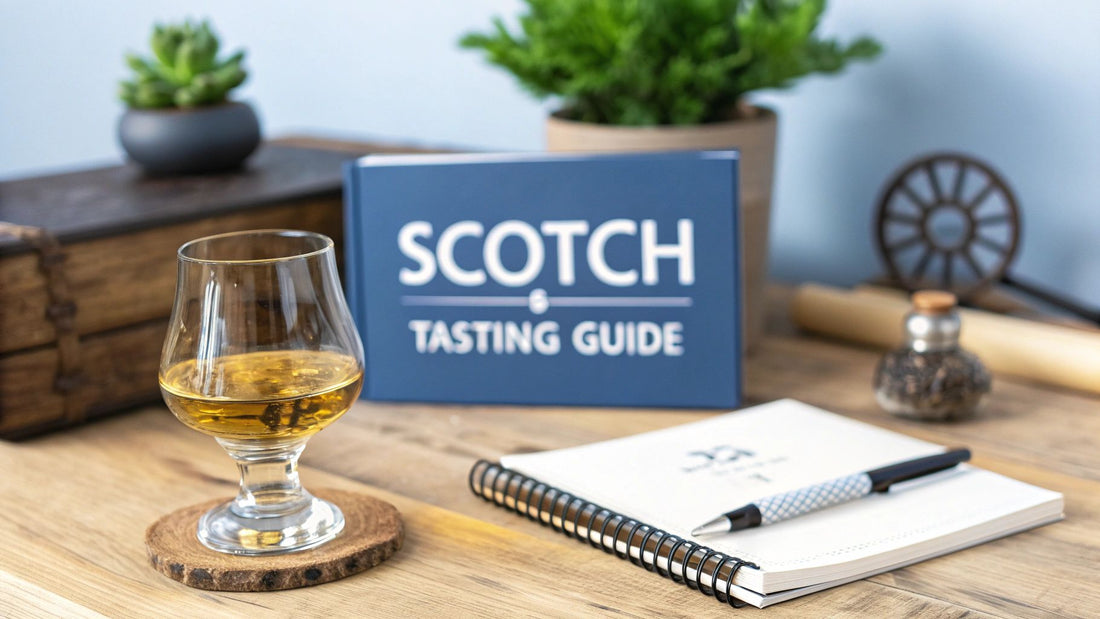Tasting Scotch whisky is really about exploration. It's a story told through aroma and flavor, and the best way to get started is to simply trust your senses, not some complicated rulebook. The goal here is to slow down, pay attention, and figure out what you actually like. Forget any snobbery you've encountered; this is for everyone, whether you're a total newcomer or a seasoned American craft whiskey fan from brands like Westland or Stranahan's.
Your First Pour A Beginner's Introduction
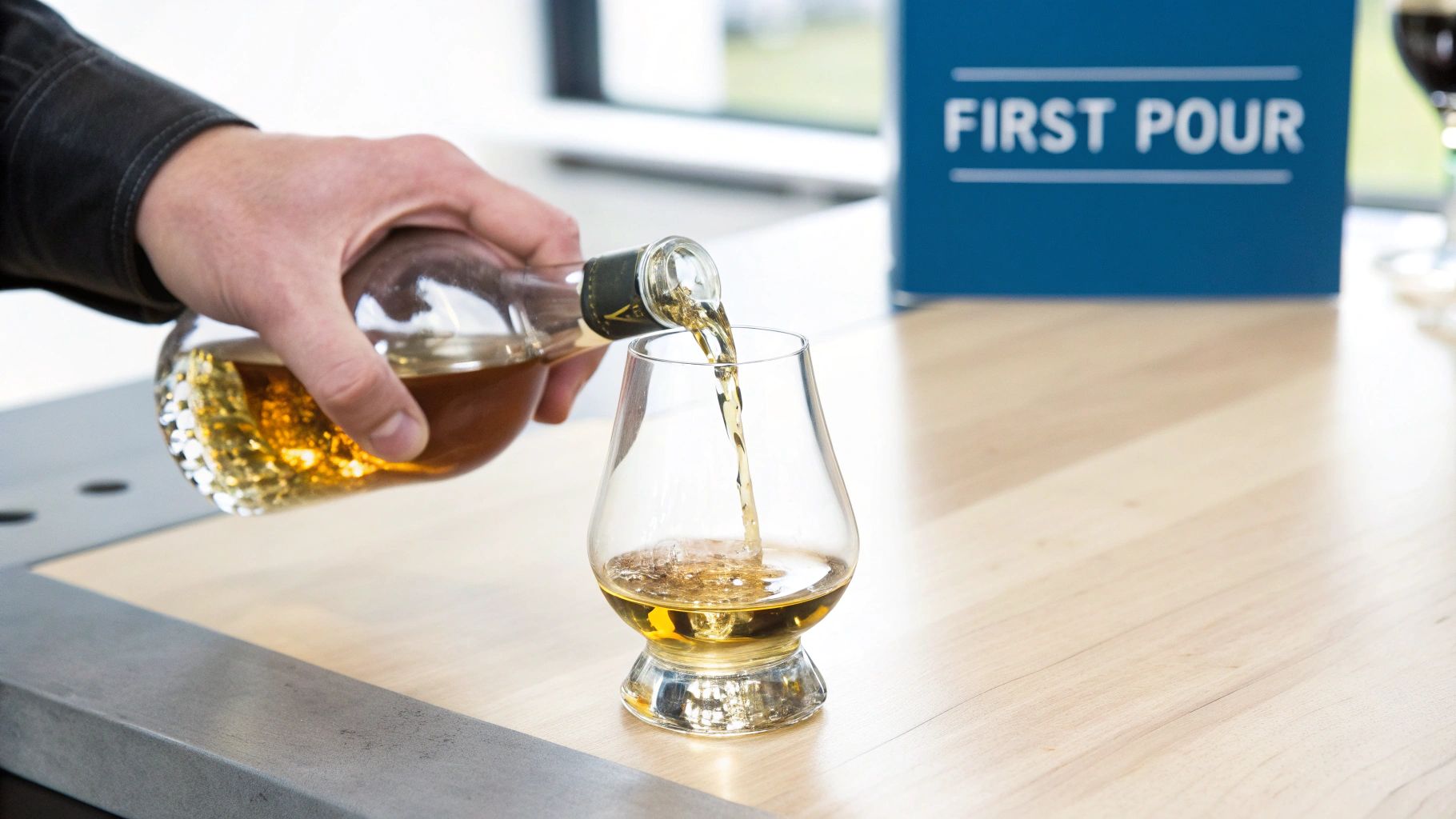
Jumping into the world of Scotch can feel a little intimidating, but the core principles are the same as any other spirit. If you've ever taken the time to really savor a complex American craft bourbon, you've already started training your palate to pick up on nuance. This journey into tasting Scotch whisky is just an extension of that same curiosity—you're just swapping notes of corn and rye for peat, heather, and sherry.
This guide is here to demystify the whole experience, right from your very first pour. We’ll skip the obscure terminology and focus on simple, practical advice that builds your confidence. It’s all about creating the right setting and using a few key tools to let the whisky do the talking.
Setting The Stage For Success
Before you even think about popping a cork, a little prep work can make a world of difference. The sensory experience is so profound that it has helped fuel a massive global appreciation for the spirit. In fact, the global Scotch whisky market hit a value of about $34.70 billion in 2024 and is only expected to keep growing. You can learn more about the Scotch whisky market trends on fortunebusinessinsights.com.
To really appreciate what makes Scotch so special, you need to give your senses a fighting chance by cutting out the distractions.
- Find a Neutral Space: Try to do your tasting in a room without strong competing smells. Things like cooking aromas, scented candles, or air fresheners can easily get in the way of the subtle notes you’re trying to find in the glass.
- Use Proper Glassware: The shape of your glass matters more than you might think. A tulip-shaped glass, like the classic Glencairn, is specifically designed to concentrate all those aromatic compounds and funnel them right to your nose. It's probably the single most important piece of gear for a proper tasting.
- Gather Your Toolkit: You don't need a lab full of equipment. A good glass, your bottle of Scotch, and a small pitcher of cool, still water are the only real essentials. A few drops of water can "open up" the whisky by softening the alcohol's punch, often revealing new layers of flavor and aroma that were hiding.
The most important tip for a new drinker? Trust your own palate. There are no 'right' or 'wrong' answers in tasting. If you smell green apple and someone else smells pear, you're both right. It’s about your personal sensory journey.
Essential Scotch Tasting Toolkit
To get the most out of your Scotch, having the right tools on hand is key. Here's a quick rundown of the basics that will elevate your experience from just drinking to truly tasting.
| Tool | Why It's Important | Pro-Tip for Beginners |
|---|---|---|
| Glencairn or Tulip Glass | The curved shape captures and concentrates aromas, directing them toward your nose for a better nosing experience. | Don't have a Glencairn? A wine glass is a decent substitute. Avoid tumblers or rock glasses for tasting. |
| Cool, Still Water | Adding a few drops can lower the alcohol's intensity, making it easier to detect subtle flavors and aromas. | Use a pipette or a straw to add water one drop at a time. It's easy to add too much, but impossible to take it out! |
| A Clean Palate | Start with a neutral palate to ensure you're tasting the whisky, not your last meal. | A few crackers or a sip of plain water between different whiskies can help reset your taste buds. |
With just these simple items, you're well-equipped to start exploring the incredible diversity of Scotch whisky on your own terms.
How to Prepare for the Perfect Tasting
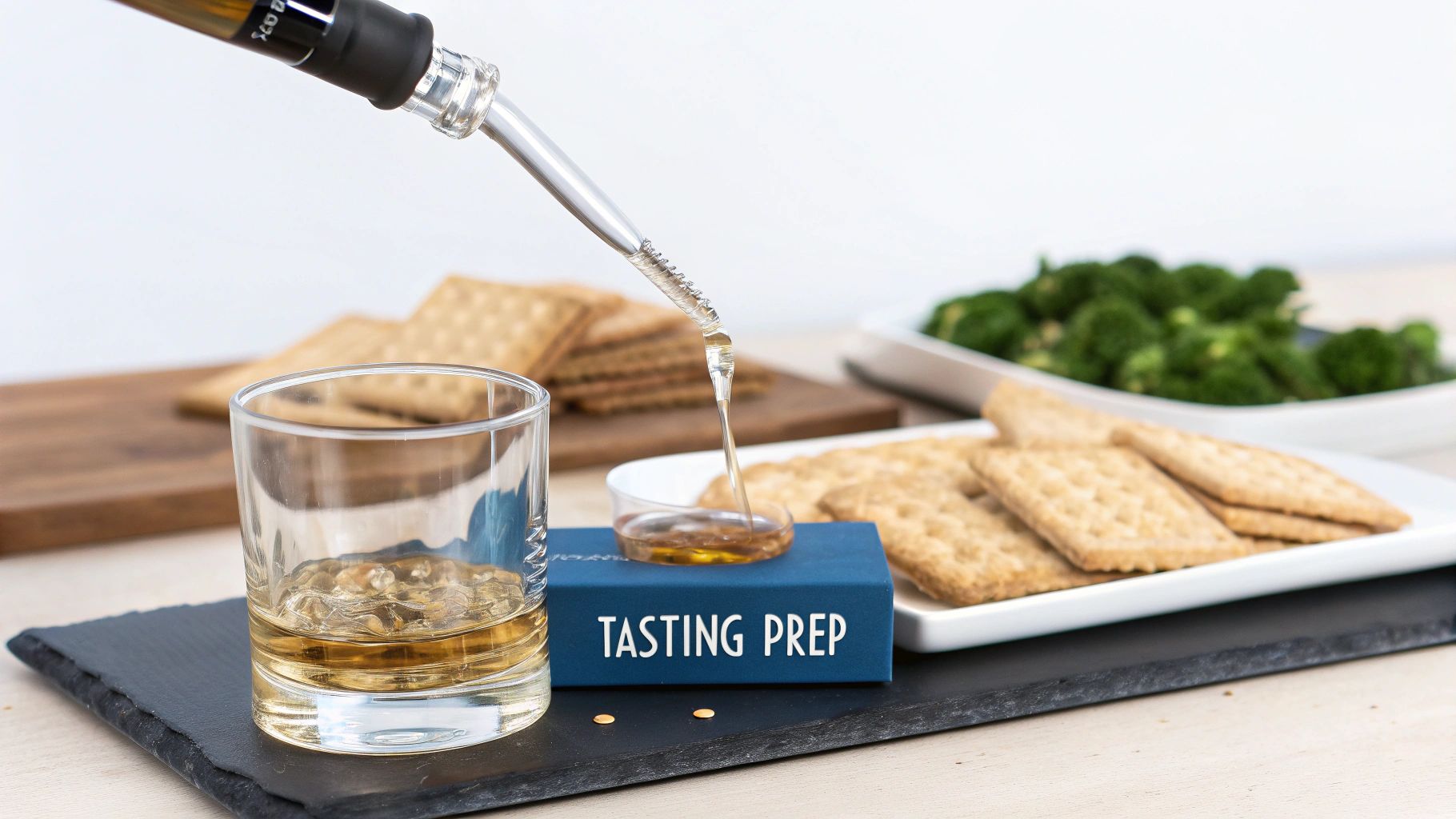
Alright, your tasting station is set and your tools are at the ready. Now for the good part. How you handle the whisky in these first few moments can make or break the entire experience. It’s not about following a stuffy set of rules, but about giving the spirit the best possible chance to reveal its true character.
Let's start with the pour. You don’t need to be heavy-handed here; about one ounce (or 30ml) is the perfect amount for a proper tasting. This gives you plenty of liquid to nose and sip without overwhelming your palate, which is especially important if you’re sampling more than one dram.
Once it's in the glass, just let it be for a minute. Seriously. Letting the whisky sit for a few moments allows it to "breathe" after being cooped up in the bottle. Those initial, sharp alcohol vapors get a chance to blow off, clearing the way for the more nuanced aromas to come through.
The Magic of Water
Here’s one of the most valuable tips for anyone new to tasting: learn to love water. A few drops can completely transform a whisky’s profile. It softens the alcohol's bite and unlocks layers of flavor and aroma that were otherwise hiding in the background. Think of it as a key turning in a lock.
This is non-negotiable for cask-strength whiskies. For any spirit bottled at 55% ABV or higher, a little splash of water is practically essential to tame the heat and let you actually taste what's going on underneath.
- Start Small: Grab a pipette or even a straw to add just one or two drops of cool, still water.
- Swirl Gently: Give the glass a light, lazy swirl to mix the water in.
- Nose It Again: Take another sniff. You’ll almost certainly notice a dramatic shift as new scents emerge.
- Taste and Repeat: Take a tiny sip. If that alcohol burn is still too aggressive, add another drop and go through the process again until you find the sweet spot.
The goal is to open up the whisky, not drown it. Be patient. You can always add more water, but you can never take it out.
Cleansing Your Palate
If you're tasting a lineup of different whiskies, keeping your palate fresh is absolutely crucial. The lingering finish from one Scotch can easily muddy your perception of the next, giving you a totally inaccurate impression. Luckily, a quick reset is simple.
A sip of cool water between drams is usually enough. For a more thorough cleanse, plain, unsalted crackers or a small piece of basic bread work wonders. They help absorb the residual oils and flavors left in your mouth, essentially giving each new whisky a clean slate.
This simple step ensures you're giving every glass your full, unbiased attention. For more pro tips on hosting, check out our complete guide to an at-home whiskey tasting.
The Art of Nosing and Unlocking Aroma
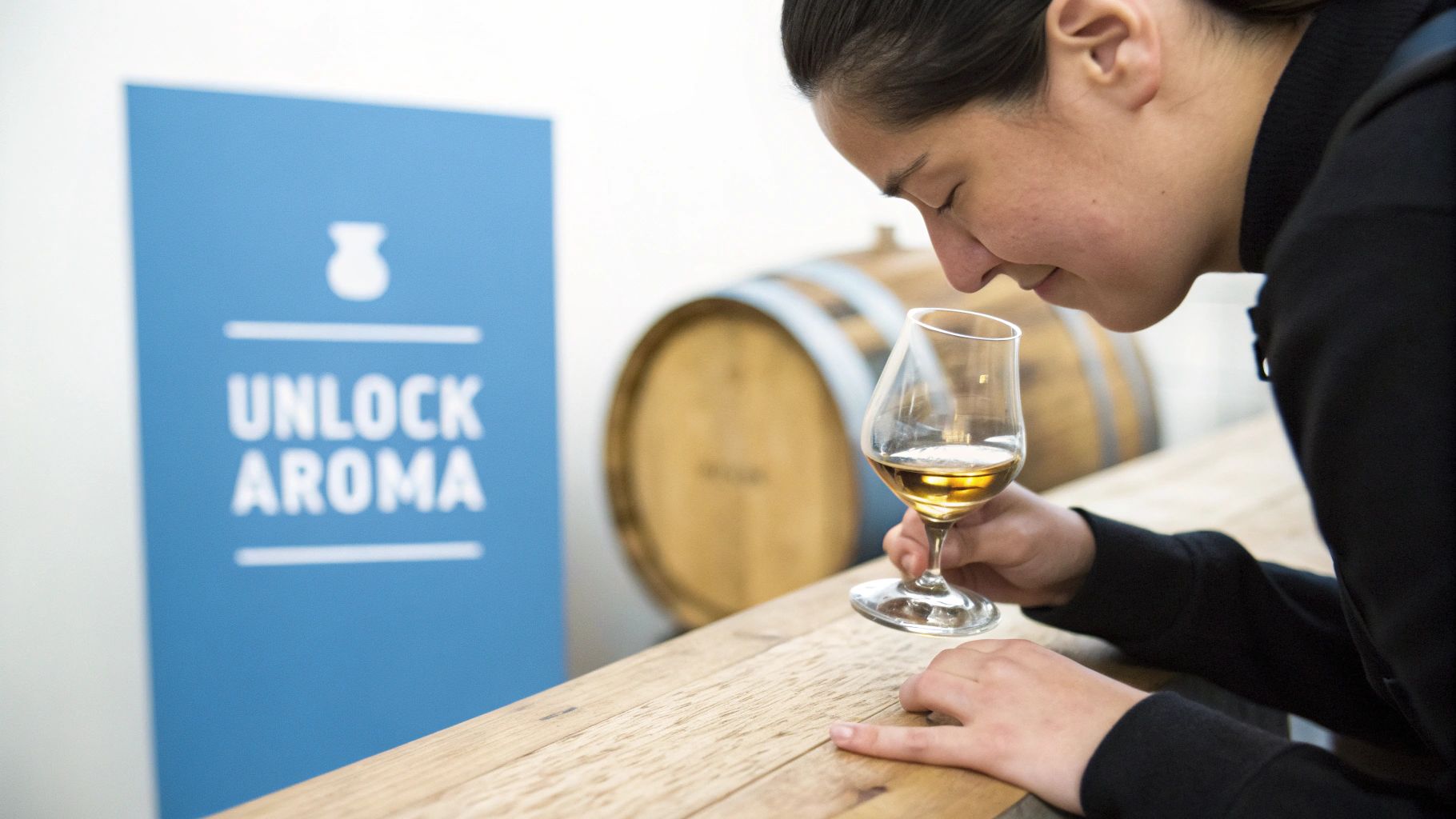
Ask any seasoned whisky drinker, and they’ll tell you that a staggering 90% of tasting is actually smelling. This first, critical step is called nosing, and it’s where you’ll find the true personality of the spirit long before it ever touches your lips. Honestly, this is the most important part of appreciating the complex art of tasting Scotch whisky.
After you've let your dram rest for a minute, give the glass a gentle, slow swirl. You’re not trying to create a whirlpool here; the goal is just to agitate the liquid a bit, coaxing all those aromatic compounds to vaporize and rise up.
Now, bring the glass toward your nose slowly. The biggest mistake rookies make is sticking their nose deep into the glass and taking a huge sniff. Don’t do it. All you’ll get is a firehose of alcohol that singes your nostrils and completely shuts down your sense of smell. Be gentle.
Proper Nosing Technique
The idea is to invite the aromas in, not to kick the door down. Keep your mouth slightly open as you breathe in through your nose. This simple trick helps circulate the air and knocks back the intensity of the alcohol, allowing the more delicate, subtle notes to come through.
Take short, light sniffs instead of one deep inhalation. Think of it like a rabbit twitching its nose—curious and quick. This method keeps you from getting overwhelmed and lets you peel back the different layers of scent.
- First Sniff: What's your immediate impression? Is it sweet, smoky, fruity, floral? Just the big picture.
- Second Sniff: Now, get a little more specific. If it's fruity, are we talking crisp green apples or more of a rich, dried fig character?
- Third Sniff: Try moving the glass from one nostril to the other. It sounds weird, but you can often pick up different notes on each side.
Don’t get hung up on being "right." The aromas you find are linked to your own scent memories. If you smell something incredibly specific, like your grandfather's workshop or a particular dessert your mom used to make, that’s a fantastic tasting note. It’s personal and completely valid.
Translating Aromas for American Whiskey Fans
If you're coming over from the world of American craft whiskey, you already know the nosing game. The mechanics are the same, but the scent profiles in Scotch can be a whole new ballgame. You're basically trading the familiar comfort of sweet corn and spicy rye for entirely new experiences.
For instance, if you love the bold oak and vanilla notes in a good bourbon from a brand like Balcones, you’ll find a comfortable starting point in a Scotch aged in ex-bourbon barrels. You'll get similar vanilla and toffee notes. The big difference? That distinct corn sweetness is gone, replaced by the malty, honeyed character of barley.
On the other hand, the smoky, almost medicinal aroma of an Islay Scotch can be a real shock to the system. There’s really no direct comparison in most American whiskies. This intense scent comes from peat smoke used to dry the barley, and it’s a signature note that defines an entire region of Scotch. It's this appreciation for wildly different flavors that drives the market. In 2024, Scotch whisky exports grew to 1.4 billion bottles, showing just how much global demand there is for these varied profiles. You can dive deeper into recent whisky industry trends on thewhiskeylab.com.
Think of it as discovering a whole new wing in the flavor library you’ve already started building.
A Practical Guide to Tasting Sip and Finish
This is the moment of truth—the main event in tasting Scotch whisky. After examining the color and unlocking the aromas, it’s finally time to take a sip. The goal isn't just to taste, but to really analyze how the whisky feels and behaves from the moment it hits your tongue to the lingering flavors that remain long after you swallow.
The first sip should be a small one. Just enough to get your palate accustomed to the alcohol. Let it gently coat your entire mouth without overwhelming your taste buds.
For those familiar with American craft whiskey, this next move will feel natural. It’s a technique often called the “Kentucky Chew,” where you lightly swish the liquid around your mouth for a few seconds. This simple action ensures the whisky makes contact with every part of your tongue and cheeks, revealing its full spectrum of flavor and, just as importantly, its texture.
Decoding the Palate and Mouthfeel
Once you’ve coated your palate, your focus splits into two key elements: the flavors you're tasting and how the liquid physically feels. The initial flavors you detect are called the palate. Are they sweet like honey and vanilla? Do you find fruity notes of apple or dried figs? Or is it something more savory and smoky, like cured meat or smoldering campfire embers?
At the same time, pay close attention to the mouthfeel. This is all about the physical sensation and texture of the whisky in your mouth. Is it thin and light, or does it feel rich, oily, and viscous? Some whiskies have a creamy quality, while others might feel more astringent or spicy, creating a slight prickle on the tongue.
Here are a few common textures to look for:
- Light & Crisp: Often feels clean and refreshing, a common trait in younger, unpeated Speyside malts.
- Oily & Viscous: Feels thick and coats the mouth, a quality often found in non-chill-filtered whiskies.
- Warming & Spicy: A gentle heat that spreads, typical of whiskies matured in certain types of active oak casks.
- Creamy & Smooth: A velvety texture that feels rounded and soft, often associated with older, well-matured spirits.
Your palate is a powerful tool, but it can get tired. Don't rush through a tasting. Take your time with each sip, and don't be afraid to take a break and reset with a little water between different drams.
Understanding the Finish
The final chapter of any tasting is the finish. This is the collection of flavors and sensations that linger after you’ve swallowed the whisky. A great finish can be just as complex and revealing as the initial taste, telling you a whole lot about the whisky’s quality and character.
Ask yourself a few questions. How long does the flavor last? A short finish might fade away within 15-20 seconds, while a remarkably long finish can evolve in your mouth for several minutes. What flavors are left behind? Sometimes the finish introduces entirely new notes that weren't present on the palate.
For instance, a Scotch aged in sherry casks might start with sweet, fruity notes but leave you with a long, warming finish of cinnamon and clove. In contrast, a classic Islay malt like Ardbeg or Laphroaig will deliver a powerful punch of smoke and brine on the palate, followed by an incredibly long, smoky finish that can last for ages.
Keeping track of these details is essential, and using a structured approach can make all the difference. Our whiskey tasting notes template is a great resource for organizing your thoughts on palate and finish.
How to Decode Flavors and Build Your Palate
This is where the real fun begins.Here's where your personal journey into Scotch whisky really starts. It's time to move beyond simple words like "sweet" or "smoky" and begin building a mental library of specific flavors. Trusting your own senses is key, and I've found that keeping a simple tasting journal makes a huge difference in tracking what you truly enjoy.
The interest in these complex spirits is exploding. Market data suggests whisky sales could jump from $118.5 billion in 2025 to a staggering $345.7 billion by 2035. A lot of that growth is coming from new drinkers who are genuinely curious about the unique character of spirits like Scotch.
Navigating the Core Flavor Categories
Generally, Scotch flavors fall into a few main families. Getting a handle on these categories helps you know what to expect when you pour a dram and gives you a solid starting point for picking out individual notes.
- Fruity & Floral: Think of crisp green apples, juicy pears, bright citrus zest, or even richer dried fruits like raisins and figs. On the floral side, you might get notes of heather honey or freshly cut grass.
- Smoky & Peaty: This is the calling card for Islay malts. The notes can range from a gentle, wispy campfire smoke to more intense, medicinal aromas like brine and seaweed. To really get what makes this category so unique, you can check out our guide on what peaty Scotch is all about.
- Spicy & Woody: These flavors are almost always a gift from the cask. You'll want to look for notes of vanilla, cinnamon, clove, black pepper, and toasted oak.
Don't get discouraged if you can't name a flavor right away. Your brain is flipping through its scent catalog. The more you taste, the quicker that recall becomes. It's a skill you build over time.
Putting Your Palate to the Test
The absolute best way to learn is by comparing whiskies side-by-side. Set up a tasting flight with drams from different regions to experience firsthand how geography and production shape the final spirit. A classic lineup might include a light, fruity Speyside; a bold, smoky Islay; and a balanced, complex Highland malt.
For fans of American craft whiskey, this is a fantastic way to draw parallels. If you already love the rich, wine-cask finishes from a distillery like Westward Whiskey in Oregon, then a sherry-matured Scotch from Speyside will feel both excitingly new and comfortably familiar. It’s the perfect bridge from what you know to a whole new world of flavor.
The infographic below does a great job of showing how different aging styles affect two crucial parts of the experience: the main flavor profile and how long the finish lasts.
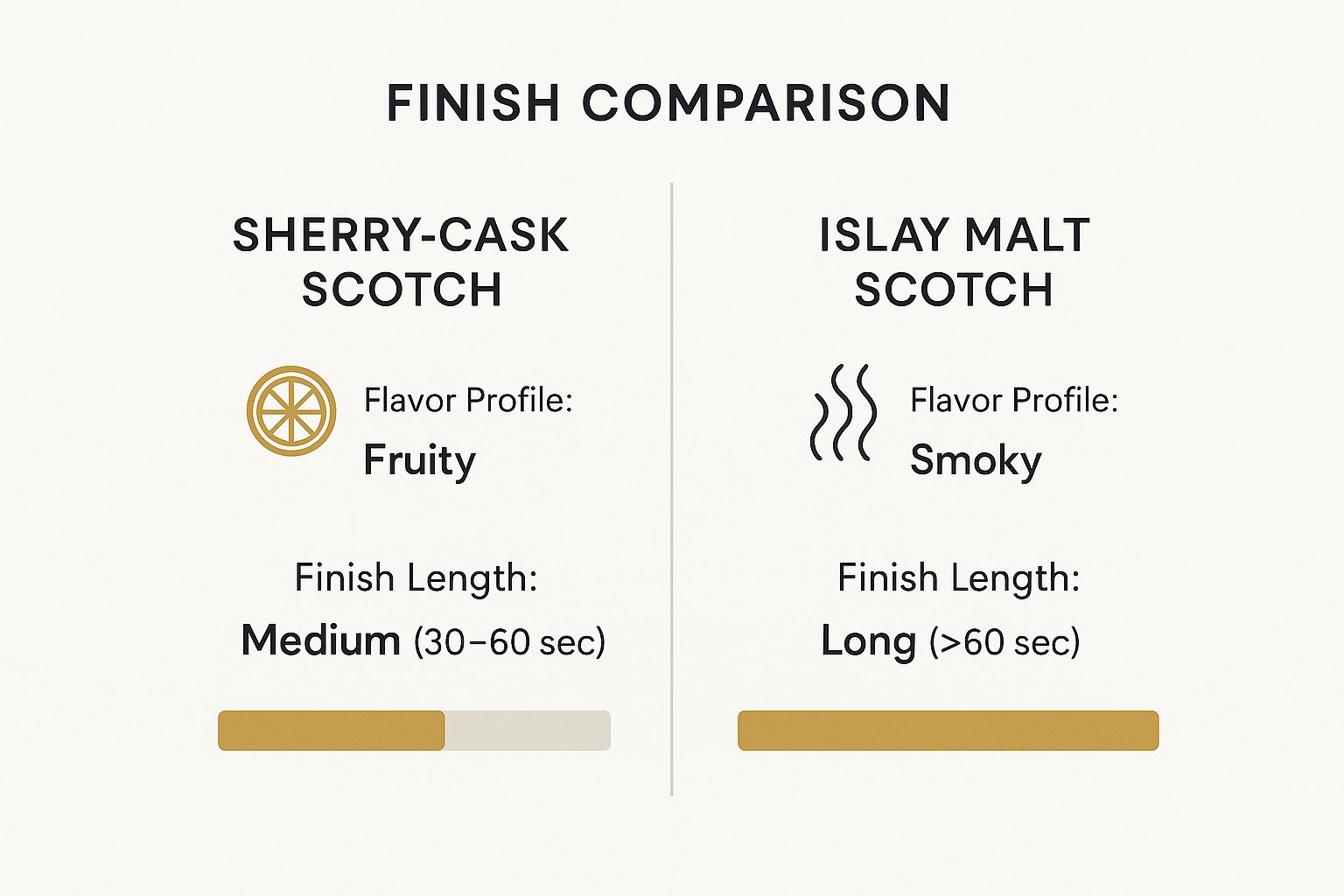
This visual really drives home the contrast between a fruit-forward, sherry-aged Scotch and a peaty Islay malt, highlighting how the finish can range from medium all the way to very long.
To get a quick sense of what to expect from Scotland's different whisky-producing areas, here’s a simple cheat sheet. It’s a great way to start connecting the dots between a region and the liquid in your glass.
Scotch Regional Flavor Profiles at a Glance
| Region | Common Tasting Notes | Example American Whiskey Parallel |
|---|---|---|
| Speyside | Fruity (apples, pears), honey, floral, vanilla. Often sherry-cask influenced (rich fruits, spice). | A high-malt bourbon or a brandy-cask finished American single malt from a brand like St. George Spirits. |
| Highlands | Diverse; can be heathery, nutty, spicy, or lightly smoky depending on the distillery. | A well-balanced American rye with both spicy and sweet notes. |
| Lowlands | Light, grassy, citrusy, and delicate. Often called "The Lowland Ladies" for their gentle nature. | A light-bodied wheat whiskey or a softer American gin (think botanicals). |
| Islay | Heavily peated, smoky, medicinal (iodine), briny, with underlying sweetness. | No direct parallel, but fans of smoky mezcal might find a kindred spirit here. |
| Campbeltown | A mix of brine, smoke, fruit, and vanilla. Known for its distinct, slightly funky character. | A coastal American whiskey aged near the sea, like from Widow Jane. |
This table is just a starting point, of course. Distillers love to experiment, but these profiles give you a reliable map for your tasting journey.
Becoming a skilled taster is all about continuously training your senses. It’s amazing how much you can improve by learning how chefs and culinary experts think. For some great tips on sharpening your senses, check out these test kitchen secrets for developing taste.
Common Questions About Tasting Scotch Whisky
As you dive deeper into the world of Scotch, you'll find that a few practical questions almost always bubble to the surface. Getting these figured out early on can really build your confidence and help you get so much more out of every dram you pour. Let's walk through some of the most common things new enthusiasts wonder about.
Do I Really Need a Special Glass?
Look, you can drink whisky out of a coffee mug if you want, but a proper tasting glass like a Glencairn makes a world of difference. It’s not just about looks. That signature tulip shape is specifically designed to concentrate all the whisky's aromas and funnel them right to your nose. This lets you pick up on the subtle complexities you'd otherwise miss.
A standard rocks glass, on the other hand, is wide open at the top, letting all those delicate scents just float away. Think of a proper glass as the single easiest and cheapest upgrade you can make to your tasting setup. It's a small investment that pays huge dividends in appreciating the spirit.
Is It Okay to Add Ice to My Scotch?
First things first: there's no "wrong" way to enjoy your whisky. If you like it on the rocks, that’s all that matters. However, when you’re doing a focused tasting session, ice is generally a no-go. The cold temperature actually numbs your taste buds and dulls many of the nuanced flavors and aromas the distiller worked so hard to create.
If you absolutely must have your Scotch chilled, your best bet is to use a single large ice cube or sphere. It melts much slower than smaller cubes, minimizing dilution. For a true tasting, though, a few drops of cool, still water is the way to go. It gently opens up the spirit without masking its true character.
Remember, the goal of tasting is to explore what's in the glass. The goal of drinking is enjoyment. Sometimes those overlap perfectly, and other times they require a slightly different approach.
I Am a Bourbon Fan—Where Should I Start?
That’s a fantastic place to start! If you're coming from the world of American craft whiskey and bourbon, your palate is already dialed into notes of vanilla, caramel, and oak from barrel aging. The most logical first step into Scotch is to find whiskies aged in ex-bourbon casks.
Many distilleries, particularly in the Speyside and Highland regions, lean heavily on these barrels. This creates an approachable and familiar flavor profile that acts as a perfect bridge.
Here are a few great entry points:
- Glenfiddich 12 Year Old: A true classic for a reason. It’s light, fruity, and has those gentle oak notes you’ll recognize.
- The Balvenie 12 Year Old DoubleWood: This one is aged in both ex-bourbon and ex-sherry casks, giving it a wonderful balance of honey, vanilla, and dried fruit.
- Glenmorangie The Original 10 Year Old: Known for its delicate, floral, and citrusy character, this is a perfect intro to the lighter side of Scotch without any intimidating peat smoke.
These expressions really let the malt character shine through while offering those familiar cask influences, making them an ideal starting point for anyone looking to start tasting Scotch whisky.
The best way to build your palate is to taste without bias. At Blind Barrels, we send you four mystery samples of American craft whiskey every quarter, letting your taste buds—not the label—decide what you love. Discover your next favorite whiskey today at Blind Barrels.
